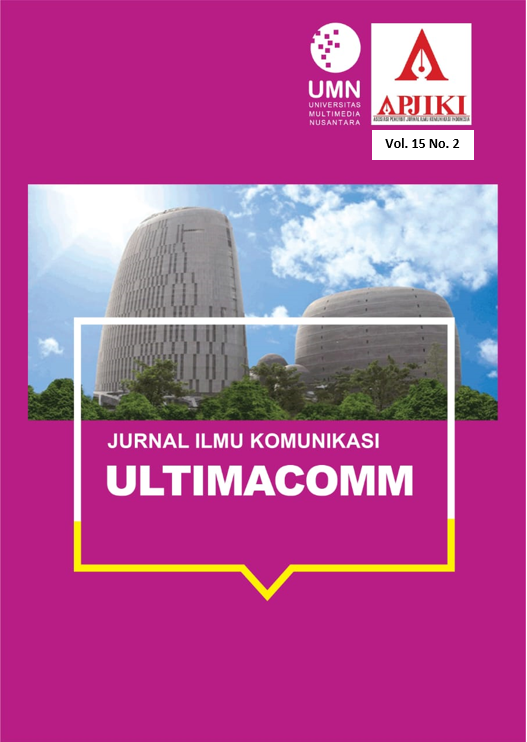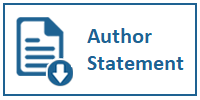Positive Trend Correlation of Jokowi's Social Media Exposure Regarding The Electability of #probowopresiden2024
DOI:
https://doi.org/10.31937/ultimacomm.v15i2.3469Keywords:
Positive trends, Jokowi social media, Prabowo electabilityAbstract
The political contestation of the 2024 presidential election in Indonesia has shown the influence of the electability of each candidate. One of them is through President Jokowi's social media, giving a positive trend for several candidates, followers give signs of support to the 2024 presidential candidates. Signs on social media have become a new trend for people in cyberspace to discuss it. The purpose of this study, how President Jokowi through his social media provides a positive trend for the 2024 presidential candidates, through new signs on social media becomes prevalent because the current president should not provide support to one of the candidates, but because the 2 presidential candidates are currently still officials in the government. President Jokowi's support on social media for presidential candidate Parbowo, who is currently the Minister of Defence, has been read by the signs given on Jokowi's social media. This will make a positive trend for Prabowo to get attention for the public. Through big data analysis on social media Instagram and twitter. The click bait media questioned where is Jokowi's support going? To Ganjar or Prabowo? The signs analysed through big data show that Jokowi is playing a role in the two 2024 presidential contenders. The sign #prabowopresident2024 received positive sentiment on facebook, Instagram and tiktok.
Downloads
References
Ardha, B. (2014). Social Media sebagai media kampanye partai ... Sosial Media Sebagai Media Kampanye Partai Politik, 13(1), 105–120.
Choi, S. (2020). When Digital Trace Data Meet Traditional Communication Theory: Theoretical/Methodological Directions. Social Science Computer Review, 38(1), 91–107. https://doi.org/10.1177/0894439318788618
Del Vecchio, P., Mele, G., Passiante, G., Vrontis, D., & Fanuli, C. (2020). Detecting customers knowledge from social media big data: toward an integrated methodological framework based on netnography and business analytics. Journal of Knowledge Management, 24(4), 799–821. https://doi.org/10.1108/JKM-11-2019-0637
Eriyanto. (2021). Metode Netnografi: Pendekatan Kualitatif dalam Memahami Budaya Pengguna Media Sosial (1st ed.). Rosda.
Fuchs, C. (2014). Christian Fuchs-Social Media_ A Critical Introduction-SAGE Publications Ltd (2013).
Gerbaudo, P. (2017). From cyber-autonomism to cyber-populism: An ideological history of digital activism. TripleC, 15(2), 478–491.
Hartanto, A. (2021). Makna Tanda dalam Iklan Politik Pemilihan Presiden Indonesia The Meaning of Sign in Political Advertising of the Indonesian Presidential Election. Jurnal Pekommas, 6(2015), 43–50. https://doi.org/10.30818/jpkm.2021.2060105
Hisan, K., & Azhar, A. A. (2020). Trend Iklan Politik Luar Ruang Dalam Ruang Media Massa. Al-Hikmah Media Dakwah, Komunikasi, Sosial Dan Kebudayaan, 11(2), 80–84. https://doi.org/10.32505/hikmah.v11i2.2543
Kozinets, R. V. (2015). Netnography"¯: Redefined 2nd Edition. Sage Publications Ltd.
Kozinets, R. V. (2020). Netnography The Essential Guide to Qualitative Social Media Research. Sage Publication, Inc.
Nasri, R. M. (2023). Communication Strategy of Sedulur Sikep Samin'S Believers in Building Positive Image in Community. Profetik: Jurnal Komunikasi, 16(1), 93. https://doi.org/10.14421/pjk.v16i1.2416
Nofiard, F. (2022). Komunikasi Politik Digital di Indonesia. Al-Hiwar"¯: Jurnal Ilmu Dan Teknik Dakwah, 10(2), 31. https://doi.org/10.18592/al-hiwar.v10i2.7548
Nugraha, N., & Saidi, A. I. (2022). Kajian hipersemiotika terhadap Rozy sebagai virtual influencer Instagram. Serat Rupa Journal of Design, 6(2), 121–137. https://doi.org/10.28932/srjd.v6i2.4767
Pentzold, C., Brantner, C., & Fölsche, L. (2019). Imagining big data: Illustrations of "big data” in US news articles, 2010–2016. New Media and Society, 21(1), 139–167. https://doi.org/10.1177/1461444818791326
Priyowidodo, G. (2020). Netnografi Komunikasi: Aplikasi Pada Tiga Riset Lapangan. 16.
Purba, G. N. (2023). Gandeng Tangan Jokowi dan Prabowo Lebih Banyak Muncul di Media. Metrotvnews.Com. https://www.metrotvnews.com/play/kewCl8zl-gandeng-tangan-jokowi-dan-prabowo-lebih-banyak-muncul-di-media
Sukri, Ariana, & Ekawaty, D. (2021). Kebijakan Pendidikan dan Media Sosial Sebagai Faktor Pembentukan Preferensi Politik Pemilih Pemula di Kota Makassar. JAKPP (Jurnal Analisis ..., 7(1), 65–80. https://journal.unhas.ac.id/index.php/jakpp/article/view/11776
Tallo, J. (2023). Berhasil Serap Suara Pemilih Jokowi, Buat Elektabilitas Prabowo Melesat Tajam. Liputan6.Com. https://www.liputan6.com/pemilu/read/5429019/berhasil-serap-suara-pemilih-jokowi-buat-elektabilitas-prabowo-melesat-tajam
Villa-Nicholas, M. (2019). Latinx Digital Memory: Identity Making in Real Time. Social Media and Society, 5(4). https://doi.org/10.1177/2056305119862643
Vyas, A. N., Nagaraj, N., Genovese, J., Malhotra, G., Dubey, N., Hingorani, R., & Manning, L. (2020). The Girl Rising ‘We Dream, We Rise' Social Media Campaign in India: Reach, Engagement and Impact. Journal of Creative Communications, 15(1), 106–124. https://doi.org/10.1177/0973258619878354
Zaman, R. K., & Misnan. (2021). Infrastruktur Politik Menuju Pilpres 2024 Dalam Konstruksi Media Sosial. Petanda"¯: Jurnal Ilmu Komunikasi Dan Humaniora Univesitas Prof. Dr. Moestopo (Beragama), 4(1), 41–53.
Downloads
Published
How to Cite
Issue
Section
License
Ultimacomm Jurnal Ilmu Komunikasi allows readers to read, download, copy, distribute, print, search, or link to its articles' full texts and allows readers to use them for any other lawful purpose. The journal allows the author(s) to hold the copyright without restrictions. Finally, the journal allows the author(s) to retain publishing rights without restrictions
1. Authors are allowed to archive their submitted article in an open access repository
2. Authors are allowed to archive the final published article in an open access repository with an acknowledgment of its initial publication in this journal















